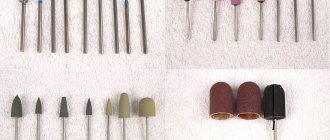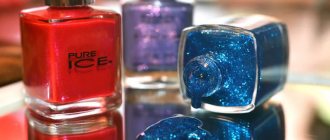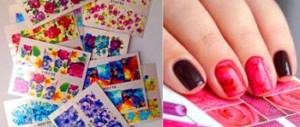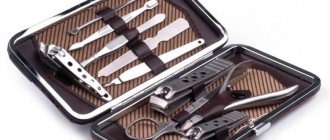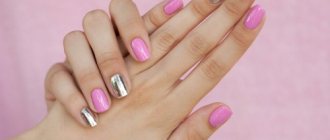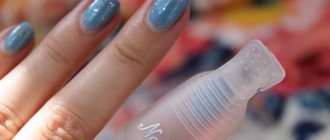To perform manicure and pedicure, the master requires a significant amount of caring and decorative products - varnishes, nail extension systems, creams, serums. All cosmetic products used in the circulation of a nail salon or by a professional at home have their own rules for storage, use and signs of unsuitability. How not to get lost in a large arsenal of cosmetics for manicure and pedicure, how to properly store and dispose of materials on time? Let's talk about the most popular manicure and pedicure products and the features of their use.
Recommendations for storage and disposal of manicure and pedicure products: general terms and rules
Each cosmetic or decorative product for manicure and pedicure has an expiration date indicated on the packaging by the manufacturer. There are a number of products whose expiration date is indicated not from the production date, but from the date of first opening of the bottle or other container. It's worth taking this into account too. It is recommended to store all cosmetics in a dry, dark, cool place at temperatures up to 24°C, away from direct sunlight and heating elements. For varnishes and gels that are subject to polymerization, it is also worth eliminating sources of ultraviolet radiation.
All containers are stored in a vertical position and transported in the same position, if necessary. Jars and bottles must be tightly closed.
After disinfection and sterilization, instruments should be stored in craft bags or in UV sterilizers until the next use . Read more about disinfection and sterilization of instruments and how best to carry it out.
At the first signs of separation of the composition of cosmetics, a change in color or the appearance of an unusual odor, even before the expiration date, the cosmetics must be disposed of. SanPiN standards do not have strict requirements for the disposal of the entire list of cosmetics, so chemicals are disposed of like other chemical compounds, plastic is sorted into plastic, and everything that can be organically recycled must be sorted separately.
The best assistant is nail polish remover
To dissolve dried varnish, use acetone liquid. First, use nail polish remover to remove any traces of nail polish on and around the cap. The order of your actions should be as follows:
- Take a cotton swab and dip it in nail polish remover or acetone.
- Turn the jar upside down. Using a cotton swab, carefully apply nail polish remover into the gap between the cap and the bottle.
- Give time for the varnish to dissolve under the influence of the liquid, then carefully unscrew the lid. If necessary, repeat all steps.
To prevent the lid from drying out in the future, use the following trick:
- There is an open jar in front of you.
- Take a cloth and soak the tip generously in nail polish remover.
- After this, carefully wipe the neck of the bottle with this cloth.
- To prevent liquid from remaining on the bottle, wipe it again with the dry side of the napkin.
- The neck threads should remain clean and dry.
Chemical compounds effectively dissolve dried varnish on the bottle neck and cap.
Nail polishes and gel polishes
Regular varnish lasts an average of 2-3 years. After the first opening of the bottle and the start of active use, this period is reduced to 1 year. Then the varnish dries and begins to flake. Before applying, it is recommended to vigorously shake it so that the composition becomes homogeneous again.
The shelf life of gel polishes is 3 years from the date of manufacture. This period is also reduced after the first opening of the bottle. Varnishes should be kept in a cool, dry place away from direct sunlight, air conditioning, and heating systems. Varnishes do not like sudden temperature changes. It is better to use closed shelves and racks, or small boxes/containers with lids that can hold several dozen bottles. Storage temperature – no higher than 26°C.
To work with gel polishes, it is recommended to equip the workplace away from the window, with good artificial lighting and an exhaust hood. When applying gel polishes, it is recommended to keep the open bottle away from the UV lamp while the coating on the nails is polymerizing.
Gel polish should not be shaken before use, like regular polish, to avoid the formation of a large number of air bubbles. They will settle on the nails for a long time. It is enough to roll the bottle in your palms a little.
Signs of unsuitability: change in color, delamination, thickening or thinning of texture, change in characteristic odor.
How to remove strengthening gel polish
Removing reinforced gel polish yourself is much more difficult than a simple coating. Of course, it is best to contact a specialist, but if you have read this far, then you probably intend to do it yourself. We will try to help you with this.
To begin with, forget everything we told you about acetone removal. When strengthening, it is strictly forbidden to soak the coating. This will cause a lot of damage to your nails, and you will most likely end up with painful, tissue-thin nails. To remove the reinforcement, you will need a device or, in extreme cases, a file. Removing a simple coating using a dry method is no different from removing reinforcement. To remove the reinforcement, use our instructions above.
The only caveat is that it will take more time to remove the reinforcement. Also, we do not recommend removing the thin base layer. After all, if you apply strengthening, it means your natural nails are weakened. In this case, it is better to cover your nails with clear varnish or gel polish, leaving a protective layer.
Gel polish remover, primer, cleanser, dehydrator
These substances are flammable and should be stored in well-ventilated areas with a temperature not exceeding 34°C. They contain alcohols, acetone, fragrances, and acids. Sometimes clinser and primer vapors can ignite at 17°C, so bottles should be kept tightly closed. You should also avoid proximity to heating elements, lamps, and sterilizers.
If all recommendations are followed, the shelf life of these products is unlimited. If the primer is frozen, then even after thawing it does not lose its properties, you must wait until it thaws at room temperature. If the bottles are not tightly closed, the liquid may simply evaporate.
Signs of unsuitability: cloudy liquid, change in odor.
Base and top for gel polishes, shellacs
Often these two formulas are combined into one, so their properties are similar. Recommendations for storing base and top coat are the same as for gel polishes. Keep them in a cool, dry place away from direct sunlight and fluorescent lamps. After using a top or base, carefully wipe the neck of the bottle to remove any residue before screwing on the cap. Otherwise, the residue will dry out and may polymerize even in daylight. It will be difficult to open the bottle, and dried particles may get into the rest of the liquid inside.
After working with varnishes or glitter, the top brush may become stained. To avoid clouding the bulk of the liquid, wipe the brush before immersing it in the bottle on a lint-free cloth soaked in cleanser.
The shelf life of the base and top is 2 or 3 years depending on the manufacturer.
Signs of unsuitability: cloudiness of the liquid, change in odor, rolling of the layer into “islands” immediately after application.
How to deal with a dried-on lid
Due to the contact of varnish or gel on the neck, the cap is firmly glued to the bottle. There are several ways to solve this problem.
Soaking in water
If the options for opening the bottle do not produce results, soaking the nail polish in a high-temperature liquid will help open the nail polish:
- Pour hot water into a shallow container.
- Place the bottle cap down in the water.
- Leave for 5 minutes and remove the bottle from the water. Now the bottle will quickly unscrew.
Only the plastic part is placed in water, because upon contact with heat, the structure of the product changes, becomes sticky, and delaminates.
Hot water
Dried particles of a cosmetic product under the lid soften using a simple method:
- Place the top of the bottle under running hot water (the higher the temperature, the better).
- The bubble should be rotated slowly.
- The procedure takes from 30 seconds to 2 minutes depending on the water temperature.
- Dry the lid from moisture so that it does not slip.
- Under the influence of water, the material of the cap expands, the dried particles soften, try to unscrew the jar.
Important! Part of the bottle with dye must be protected from the stream so as not to spoil the contents.
Available means
Increasing the grip force will help unscrew the bubble. To increase retention, an ordinary elastic band is used.
If you don’t have it on hand, use tape or a fabric bandage. Take adhesive materials with a minimum width of 1 cm.
A rubber band is placed on the cap of the bottle. It will take more than 3 coats to eliminate slippage. This will help grip the cap and make it easier to turn.
Rubber bands for banknotes
In most cases, the problem with opening the varnish is the thinness of the lid. I can't get my hands on it enough to turn it tightly enough. Ordinary rubber bands for banknotes will help correct the situation. Twist them in half, put them on your fingers, then tightly wrap them around the bottle cap. If necessary, use several pieces to ensure a tight grip. You will be able to open even those bottles that are equipped with a sharp and thin cap.
Acrylic powder for nail extension systems
It is recommended to store the powder at a temperature not exceeding 40°C, in a dry and cool place. The shelf life of acrylic powder is from 3 to 5 years from different manufacturers. It should not interact with water and other liquids other than the monomer, otherwise it loses its properties, color and texture, and stops polymerizing when interacting with the liquid. When disposing of the powder, do not pour it down the drain or scatter it in an open place, so as not to provoke allergic reactions if inhaled.
Signs of unsuitability: discoloration, clumping into lumps and flakes, loss of polymerization properties.
How to dilute thickened nail polish?
Nail polish thickens because the liquid evaporates from it. Knowing this, you can use a lot of ways to bring it back to life.
- Special product for thinning varnish. Manufacturers know that varnishes often dry out, and therefore they came up with thinners. They are sold in the same department where varnishes are sold. Instructions for use are written on them. In appearance, the thinner is a transparent liquid resembling varnish
- Add varnish without color. This method will not help save your favorite polish. But on the other hand, the colorless product will take on some of the color and can be applied to the nails
- The easiest and most affordable way is to add nail polish remover. You don't need much of it to make the varnish come to life. Unfortunately, the effect is temporary
- Heating the varnish is another easy way. To do this, heat the water until hot and place the varnish in it for 10-15 minutes. After this, the varnish can be used again
- Paint thinner. It would be useful to remind you that paint thinner is a strong chemical and is not very beneficial for nails and skin. However, if there is no other way out, the varnish can be diluted with it.
Ways to thin nail polish
Liquid or monomer for polymerization of acrylic powder
It is considered a chemically hazardous substance with a high degree of fire hazard and toxicity. The liquid must be handled and stored in well-ventilated, dry and cool areas equipped with an exhaust hood for the nail extension procedure.
The recommended storage temperature should not exceed 30°C due to the risk of fire. Also, there should be no heating sources nearby, direct exposure to sunlight, or other chemicals with the vapors of which the liquid could interact.
The recommended shelf life of the monomer is 3 years.
Signs of unsuitability: hardening, clouding, acquisition of a gel-like texture, loss of polymerizing properties upon contact with acrylic powder. To dispose of the monomer, use a napkin or paper towel for absorption and a container. For large quantities – earth or sand. Do not pour into the sewer.
UV gels for nail extensions
Compared to gel polishes, gels for nail extensions have a much longer shelf life - up to 10 years. It is recommended to store them in a dark, cool and dry place, in a sealed container or box, away from heat and sunlight. UV gels polymerize when exposed to direct sunlight, causing the material to harden and become unusable.
Signs of UV gel unsuitability: change in color, clouding, change in texture towards greater viscosity or delamination, change in characteristic odor.
What can I do to make the lid easy to open in the future?
To quickly open the jar at any time, you should follow simple recommendations for using and storing manicure products:
- Always seal the tube tightly after use. When applying gel polish, do not leave the bottle open for a long time.
- Dyes should be stored in a standing position - this will limit the penetration of liquid under the cap.
- When painting your nails, do not leave excess product on the neck.
- You can prevent drying by thoroughly wiping the threads on the bottle; to do this, use nail polish remover. Soak a piece of cloth in solvent, treat the outside of the bottle, and dry with a dry towel. Repeat the procedure until completely cleansed. Tighten the bottle only after the surface has completely dried.
- Store in a cool and dry place away from direct sunlight. Heat and light help thicken the contents.
Sources
- https://www.furnishhome.ru/article-4244-srok-godnosti-laka-dlya-nogtey-chto-delat-esli-on-isportilsya-i-kak-pravilno-ego-khranit.html
- https://tn-club.ru/instrumenty/kak-hranit-gel-laki.html
- https://salon-lime.ru/manicure-and-pedicure/kak-hranit-lak-dlya-nogtej
- https://kakxranit.ru/raznoe/kak-xranit-lak-dlya-nogtej.html
- https://potrebitelinfo.ru/tovary/sroki/skolko-sostavlyaet-srok-godnosti-laka-dlya-nogtej.html
- https://jawoman.ru/krasota/nogti/kak-otkryt-lak-dlja-nogtej.html
- https://city-glam.ru/raznoe/ne-otkryvaetsya-lak-dlya-nogtej.html
- https://www.wday.ru/dom-eda/soh/tri-sposoba-otkryit-zasohshiy-lak-dlya-nogtey/
Glue for fixing tips and other elements in manicure
It is recommended to store the glue away from sources of open flame, sunlight, air conditioning, and at temperatures up to 40°C. Do not pierce the tube, otherwise the glue will dry out. It is necessary to close the lid tightly after each use and remove any remaining adhesive from the neck with a paper or lint-free napkin.
Shelf life: for most manufacturers it is 1 year from the date of production. After opening the tube for the first time, the product may dry out quickly, so you need to ensure that the cap is tightly sealed.
Signs of unsuitability: dryness, viscosity, fibrousness, formation of lumps.
Hand and foot cream
At the final stage of manicure and pedicure, it is recommended to use a nourishing or moisturizing cream. It usually comes in large containers of 250 ml. It is recommended to store cosmetics in a cool, dry place away from direct sunlight. Shelf life is 3-4 years from the date of production at temperatures up to 27°C. After the first opening of the bottle, the cream retains its properties for 12-16 months. When exposed to sunlight and heat, oily textures can separate, releasing oils onto the surface. This happens due to the evaporation of moisture and a change in the proportions of the composition. Dispenser containers can help in this situation.
Signs that hand or foot cream is unsuitable: change in texture towards more liquid or vice versa, more dense, viscous; release of oils on the surface of the product, delamination of the composition, change in odor, formation of small flakes or lumps.
Opening a new varnish
If the bottle has not been opened before, and attempts to unscrew the cap ended in failure, it is recommended to take the following steps:
- Make sure that all protective and decorative covers have been removed from the bottle. Hold the cap with two fingers and pull upward with force.
- If the top is difficult to grip and your fingers slip off the surface, you need to tighten your grip. Wrap the lid in a towel or wear rubber gloves. Turn the cap firmly counterclockwise and try to unscrew it.
If the methods are unsuccessful, try methods for opening a dried-on lid. Most likely, the difficulties arose due to improper storage.
Scrubs, masks for manicure and pedicure
Storage recommendations are the same as for creams - in a dry, cool place away from heat sources and direct sunlight.
Shelf life: up to 2 years subject to storage conditions. Products based on natural oils – up to 6-12 months. It is necessary to look at the designation on the packaging.
Signs of unsuitability: change in consistency, appearance of an uncharacteristic odor, especially for oily compositions, hardening due to evaporation of moisture, separation of the composition into liquid, oils and solid particles.
Paraffin for paraffin therapy of hands and feet
It is recommended to store paraffin in a cool, dark place away from sunlight and heat sources as it may melt. Classic paraffin without impurities and additives has an unlimited shelf life. The composition with cosmetic additives will last up to 2-3 years, subject to storage and operating conditions. Product with natural additives – up to 4-6 months.
It is recommended to store paraffin in plastic containers or bags. It is recommended to change the composition in the paraffin melter every 4-6 months with a large flow of clients.
Signs of unsuitability: change in color, separation of texture in the presence of additives, change in odor in the case of fragrances. Natural paraffin without additives can be melted down in case of deformation under the influence of heat, and folded into a mold for further storage.



